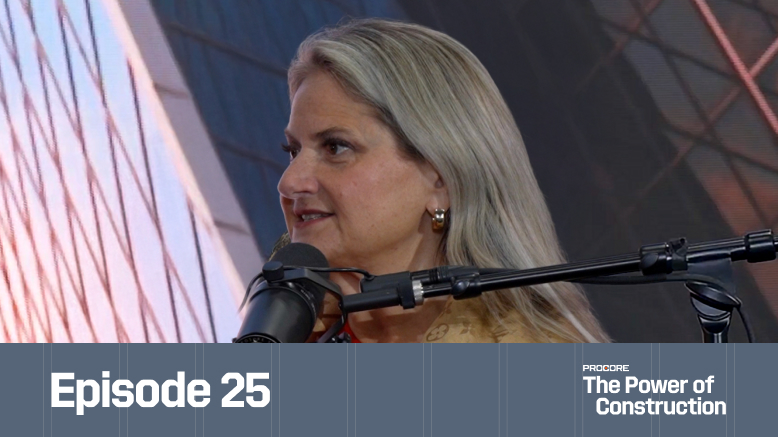— 10 min read
Construction Documents (CDs) Explained: From Design to Construction


Last Updated Aug 5, 2025

Mary Carroll-Coelho
Product Operations
12 articles
Mary Carroll-Coelho is a Product Operations Manager at Procore. A licensed Architect, Mary previously worked for KieranTimberlake, an architecture firm in Philadelphia, in construction and product operations at WeWork, and Director of Customer Success at Willow. She holds a Master of Architecture from the University of Pennsylvania. Outside of work, she volunteers as a mentor in the Spark program.

Taylor Riso
Contributing Writer
91 articles
Taylor Riso is a marketing professional with more than 10 years of experience in the construction industry. Skilled in content development and marketing strategies, she leverages her diverse experience to help professionals in the built environment. She currently resides in Portland, Oregon.
Last Updated Aug 5, 2025

Every construction project — whether it's a residential home, a commercial building, or a major infrastructure development — depends on a detailed set of documents to guide the construction process from start to finish.
In this article, we explore construction documents, discuss their purpose and importance and break down their various components. We also discuss the tools and software used to create them, the challenges faced during their development and best practices for effective coordination.
Table of contents
What are construction documents?
Construction documents (CDs) are the detailed set of construction drawings that translate the architect’s vision into a tangible plan for builders and contractors. These comprehensive plans encompass every facet of the construction process, from structural components to mechanical systems, electrical layouts and plumbing installations. Each element is meticulously documented to ensure that every aspect of the building is precisely considered and clearly communicated to all parties involved in the construction process.
Purpose and Importance
The primary purpose of construction documents is to convey the complete intent of the building's construction to all stakeholders, ensuring that the design can be accurately built by the general contractor and subcontractors. These documents serve as the guide for construction, detailing every element from structural components to mechanical systems, electrical layouts and plumbing installations.
Phases and Progression
Construction documents are part of a broader project timeline that includes multiple design phases.
Schematic Design (SD)
This phase focuses on conceptualizing the project and exploring design options.
Design Development (DD)
This phase further refines the design based on feedback from the owner and stakeholders. The 100% DD set is often considered a pricing set. The owner will use this drawing set to gauge the current cost of the project.
Construction Documents (CD)
This phase involves the creation of detailed drawings and specifications necessary for construction. This phase is generally the longest and has the most “check points” or percentage breaks. On larger projects, it’s common to have a 50% CD set, a 75% CD set, a 95% CD set and 100% CD set.
The progression through these phases involves increasing the level of detail and specificity in the construction drawings. As the project moves into the CD phase, these details are refined even further to include exact materials, dimensions and construction means and methods. This approach ensures that every aspect of the design is clearly communicated and ready for execution onsite.
Components of Construction Documents
Construction documents encompass a wide range of detailed drawings and specifications. The sections of a CD set vary widely based on the scale and scope of the project. Projects can include civil drawings, landscape drawings, specialty equipment drawings (like industrial kitchens), etc. Some of the most common sections include:
Architectural Drawings
Detailed plans showing the layout, dimensions and construction of each part of the building.
Structural Drawings
Documents that outline the structural framework and support systems of the building.
Mechanical, Electrical and Plumbing (MEP) Drawings
Plans that detail the HVAC systems, electrical wiring and plumbing systems.
Schedules
Comprehensive lists of materials, fixtures and equipment specified for the project.
For instance, in the CD phase, detailed drawings for every door type in a building — including construction details for the jambs, headers and thresholds — are provided. In contrast, during the DD phase, the documents might only specify the general type of doors and their locations without those details.
Coordination and Collaboration
The creation of construction documents requires extensive coordination and collaboration among various consultants, including structural, mechanical, electrical, and plumbing engineers. Regular coordination meetings are essential to ensure that all systems work together without conflict. This collaborative effort is crucial for preventing issues during construction and ensuring that the project adheres to all regulatory requirements.
Software and Tools Used to Create Construction Documents
Utilizing specialized software to create construction documents helps to ensure accuracy, efficiency and coordination between various scopes of work. The choice of software, such as CAD (Computer-Aided Design), Revit or competitors like ArchiCAD, is typically determined before the contract is signed. This early decision sets the foundation for the detailed phases that follow, streamlining the process and maintaining consistency as the project progresses.
CAD and Revit
CAD and Revit are the primary tools used for creating detailed 3D models in the construction document phase. CAD software is traditionally used for 2D drawings but can also handle 3D modeling, while Revit is specifically designed for Building Information Modeling (BIM), allowing for more dynamic and detailed representations of the building.
By using these tools from the initial phases, the process of creating detailed documentation is faster and much more streamlined. The tools allow for better coordination across systems and allows design teams to find issues earlier.
Backgrounds
In the design stage, architects frequently send out information known as "backgrounds" to consultants, such as structural, mechanical and electrical engineers. These backgrounds serve as the foundational drawings — illustrating the spatial planning of the building — that consultants use to develop their own detailed models.
By working from the same set of backgrounds, consultants provide assistance in coordinating and aligning designs with the overall architectural vision. Regular updates to these backgrounds are crucial for preventing discrepancies and conflicts between different disciplines, which is essential for the coordination of building components.
Coordination Across Trades
The use of common software platforms like CAD and Revit facilitates better coordination among the various trades involved in the execution of a construction project. For instance, when architects update the background drawings, these updates can be easily shared with all consultants, who then adjust their models accordingly. This integrated approach helps maintain consistency, reduces errors and ensures that all aspects of the building design are compatible with each other.
By choosing the appropriate software early on and maintaining clear communication through shared backgrounds, architects and consultants can work together more effectively to bring the architectural vision to life.
Construction Documents to As-Builts
Construction documents are intended to document the intent for the project, representing a fully developed and detailed plan. However, the reality of construction often necessitates changes and adjustments, leading to an evolution of these documents through various stages — from CDs to bidding sets, and ultimately as-built drawings.
From Construction Documents to Bidding Set
Construction documents are intended to represent a 100% complete and precise plan for the building. However, despite their intended completeness, CDs often serve as just a starting point. The complexities and unpredictabilities of real-world construction frequently necessitate changes and adaptations, illustrating that the notion of CDs being fully complete can be somewhat misleading.
Once the CDs are completed, they are reviewed by the client and then issued as a bidding set to contractors. During this bidding process, a few steps take place.
Contractor Review
Contractors analyze the bidding set to prepare their bids.
Requests for Information
Contractors submit requests for information (RFIs) to clarify ambiguities or request additional details. This process often highlights areas where the CDs may need further refinement.
Bid Submission
Based on the information provided, contractors submit their bids for the project.
Even during the submission stage, the CDs can undergo revisions based on the feedback and questions raised by the contractors during the bidding stage.
Adapting During Construction
The construction phase demonstrates that CDs, while intended to be final, often undergo changes. As construction progresses, field conditions and unforeseen challenges often necessitate changes.
Implementation
After bidding, contractors will be issued a new set of CDs, often called the “For Construction” set.
Coordination Meetings
Regular meetings help address issues and ensure alignment among all trades.
Field Changes
Adjustments due to site conditions or other factors are documented through RFIs and change orders. These changes can range from minor adjustments to significant deviations from the original plan dictated in the CDs.
Sketches (SKs)
:Often issued with RFIs, SKs are preliminary drawings or rough representations that architects create to explore ideas and concepts for a project.
Supplemental Information (SIs)
Also referred to as Architecture Supplemental Information (ASIs), SIs are larger packets that collect a group of changes together for efficient communication.
These field adaptations illustrate the gap between the idealized 100% CDs and the practical realities of physical construction.
Finalizing with As-Builts
As construction nears completion, the focus shifts to creating as-built drawings. These drawings capture all the changes and modifications made during construction, providing an accurate record of the final state of the building:
Documenting changes
All deviations from the original CDs are noted, including changes in dimensions, locations, materials and other specifics.
Final Verification
The project team verifies that the as-built drawings accurately reflect the completed project.
Usage
These as-built drawings then serve as a critical reference for facility managers, maintenance teams and future renovation projects, ensuring they have an accurate understanding of the building's actual construction.
While construction documents are designed to be a complete and precise blueprint for a project, the reality of construction often results in changes and adaptations. From the initial CDs to the bidding set, through the construction phase and finally to the creation of as-built drawings, the actual project evolves.
Challenges and Best Practices in the CD Phase
The construction document phase tees up the execution of the project. However, this phase comes with its own set of challenges. Addressing these challenges effectively and implementing best practices can lead to smoother project delivery and fewer issues during construction.
Challenges in the CD Phase
One of the significant challenges in the CD phase is the complexity of coordinating the variety of consultants and disciplines. Ensuring that the work of all consultants, such as structural, mechanical, electrical and plumbing engineers, is cohesive is vital. Misalignment between these systems can lead to costly changes and delays. Regular coordination meetings are essential to address and resolve these issues, ensuring that all details align and meet regulatory requirements. Frequent and continuous communication helps in identifying and solving problems early, thus avoiding major revisions later on .
Best Practices for Effective Coordination
Implementing these best practices can help to mitigate the challenges faced during the CD phase:
Early Involvement of the General Contractors
Involving GCs early in the design phase can significantly reduce the number of RFIs, lower contingencies and improve the working relationship between architects and contractors. Early GC involvement allows for more-realistic cost estimation, identification of potential constructability challenges and more accurate scheduling.
Integrated Project Delivery
Adopting an Integrated Project Delivery (IPD) approach allows for direct collaboration between all parties from the outset. By integrating architects, engineers and contractors from the beginning, IPD often leads to more efficient project delivery and fewer changes during construction. This collaborative approach ensures that all stakeholders are aligned and working towards the same goals, reducing the likelihood of miscommunication, errors and rework. Unlike traditional methods where different teams work in silos, IPD fosters a cohesive working environment where continuous communication and shared responsibilities enhance overall project outcomes.
Checklists
Having a comprehensive checklist for different design phases (SD, DD, CD) helps ensure all necessary details are included and coordinated. A checklist serves as a valuable tool for architects and project managers, ensuring that nothing is overlooked and that all aspects of the project are thoroughly documented and reviewed. This practice helps maintain consistency and quality across all phases of the project.
Successfully navigating the CD phase requires careful planning, effective communication and thorough documentation. By addressing coordination complexities, involving GCs early, and using tools like checklists, project teams can enhance the efficiency and accuracy of the construction process. These best practices help deliver projects that are well-coordinated, on-time, and within budget, ultimately ensuring that the architectural vision is realized to its fullest potential.
Ensuring Success Through Detailed Construction Documents
The success of any project is greatly supported by construction documents, which provide a detailed roadmap that ensures every aspect of the construction process is meticulously planned and executed. These documents are essential for communicating the design intent to all involved parties, preventing miscommunication, avoiding costly errors and ensuring compliance with regulatory requirements.
The comprehensive nature of construction documents, encompassing structural, mechanical, electrical and plumbing details, enables project teams to make informed decisions and coordinate efforts effectively. By laying out a clear and detailed construction plan, construction documents enable all project stakeholders to align their strategies and actions with the project's goals. This approach not only ensures the successful completion of the project but also its long-term viability and functionality, ultimately bringing the intended architectural vision to life.
Was this article helpful?
Thank you for your submission.
92%
8%
You voted that this article was . Was this a mistake? If so, change your vote
Scroll less, learn more about construction.
Subscribe to The Blueprint, Procore’s construction newsletter, to get content from industry experts delivered straight to your inbox.
By clicking this button, you agree to our Privacy Notice and Terms of Service.
Thank you!
You’re signed up to receive The Blueprint newsletter from Procore. You can unsubscribe at any time.
Categories:
Written by

Mary Carroll-Coelho
Product Operations
12 articles
Mary Carroll-Coelho is a Product Operations Manager at Procore. A licensed Architect, Mary previously worked for KieranTimberlake, an architecture firm in Philadelphia, in construction and product operations at WeWork, and Director of Customer Success at Willow. She holds a Master of Architecture from the University of Pennsylvania. Outside of work, she volunteers as a mentor in the Spark program.
View profile
Taylor Riso
Contributing Writer
91 articles
Taylor Riso is a marketing professional with more than 10 years of experience in the construction industry. Skilled in content development and marketing strategies, she leverages her diverse experience to help professionals in the built environment. She currently resides in Portland, Oregon.
View profileExplore more helpful resources

Defending Against Financial & Legal Risks on Megaprojects
The construction industry has seen marked growth in megaprojects. Some experts classify any project over $500 million as a megaproject, while others argue that the build needs to be $1...

Unlocking Project Intelligence: Moving from Raw Data to Actionable Insights
The construction industry faces a wide range of challenges, from ongoing labor shortages to frequent cost overruns. But some the biggest hurdles all stem from unpredictability. The general contractors (GCs)...

Who is accountable for innovation in construction?
Everyone says construction needs to innovate—but no one agrees on who’s actually responsible for making it happen. Is it the owner? The builders? The tech vendor? Or is innovation everyone’s...

Integrated Project Delivery in Practice: A Framework for Collaboration
On construction projects, traditional delivery methods put different stakeholders in their own silos. While the design team feeds drawings and specifications to the general contractor (GC), the GC’s expertise in...
Free Tools
Calculators
Use our calculators to estimate the cost of construction materials for your next project.
Templates
Find a template to help you with your construction project tasks.
Material Price Tracker
Get the latest U.S. retail prices and view historical trends for common building materials.
Glossary
Explore key terms and phrases used in the industry.
